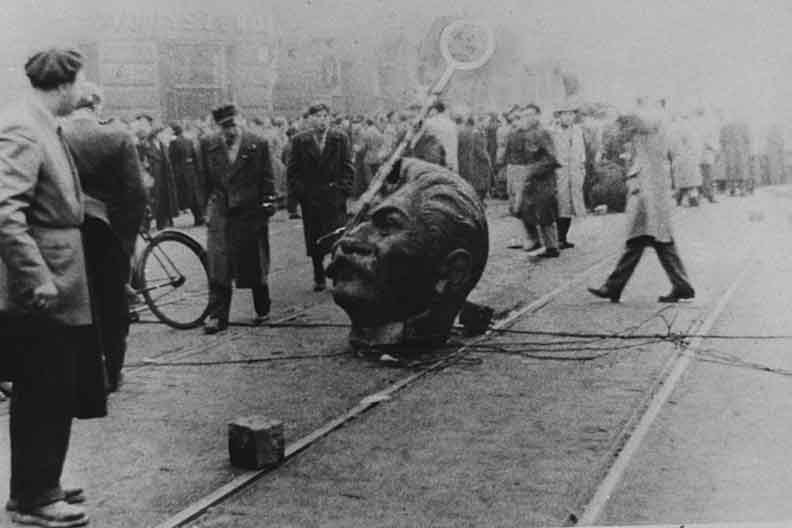1956 Hungarian Uprising

Budapest
Rioting against the Russians erupted throughout Hungary. Imry Nagy became Premier and demanded the withdrawal of Soviet troops. The Soviets initially complied, but changed course and returned to Budapest to put down the revolt. Thirty thousand revolutionaries were killed. The uprising lasted from October 23 to November 6th. Two years later, Imry Nagy was executed for his part in the uprising.
In February 1956, Soviet Premier Nikita Khrushchev gave a secret speech where he unveiled many of the horrors perpetrated by Stalin. He gave the address to the 20th Congress of the Communist Party of the Soviet Union. Delegates were instructed not to spread the word of the speech. However, representatives from other countries were present in the auditorium for the expression and word spread.
The speech had an impact in both Czechoslovakia Poland and Hungary were demonstrations broke out against the Communist regimes. In Hungary, the government released political prisoners. In June, a group of writers and intellectuals held there first public meeting. They called themselves the Petofi Circle - After a famous Hungarian revolutionary.
Demonstrations continued in Poland, and the Wladyslaw Gomulka, who had been imprisoned, was made the First Secretary of the Polish Communist Party. At the same time, Soviet troops made their presence felt. Gomulka announced that there would be limited freedom of speech and no additional forced collectivization. At the same time, he also made it clear that Defense ties between Poland and the Soviet Union were unbreakable.
In Hungary, demonstrations broke out to support the Poles. Those demonstrations soon morphed into a demand that elections be held, and that Soviet troops be withdrawn from Hungary. One of their demands was the Imre Nagy, who had been forced to resign a year earlier by the Soviets be reinstated as Prime Minister.
Demonstrators knocked down a statue of Stalin, and there were demonstrations all over the country. The First Secretary of the Communist Party Erno Gero called on the Soviets to send in troops to help put down the protests. His call only enraged the demonstrators who took to the streets in the thousands. Some of the Polish soldiers who were ordered to stop the demonstrations switched sides and joined the demonstrators.
The Soviets claimed it was all an imperialist plot. On October 25th, 1956, a massive demonstration was held outside the Parliament building. Troops opened fire on the demonstrators, and as many as 600 may have been killed. The killings further enraged the Hungarian public. Hungarians began attacking Soviet troops and even tanks.
Noel Barber the correspondent of the Daily Mail reported:
“As I moved deeper into the city, every street as smashed. Hardly a stretch of tramcar rails was led intact. The uncle of hanging electric cables was denser than Buda. Even before I reached the Duna Hotel, I counted the carcasses of at least 40 Soviet tanks.
Resistance to the Soviets grew, and on October 27th Imre Nagy formed a new government. The new government included noncommunist members. The next day he called on the army and the police to stop fighting and for Soviet troops to withdraw, which they began doing.
For a brief moment, it looked like democracy and freedom had prevailed in Hungary. On October 31st Boris Kidel reported the New Chronicle:
Hungary Today breathed ifs first day of freedom. From the underground, emerged banned non-communist parties to reopen their headquarters and district offices for the first time since the Communist seized power free newspapers appeared on the streets. And the revered Cardinal Mindszenty who had come to symbolize Hungary’s struggle against Communism returned a free man to Budapest.
However, that moment was short, as the Soviets were streaming troops and tanks into Hungary. On the evening of the November 1st Nagy broadcast to the Hungarian pope that “ The Hungarian people desire consolidation and further development of the the achievements of its national revolution without joining any power bloc. The centuries-old dream of the Hungarian people is being fulfilled” But it was already too late, Soviet troops were headed to Budapest. Nagy appealed to the United Nations and the Western Powers for support in stopping the Soviets, that plea went unanswered.
At 4 AM, November 4th Soviet troops entered Budapest. Nagy broadcasted to the Hungarian people,” TodayToday at daybreak Soviet forces started to attack our capital, obviously with the intention of overthrowing the legal Hungarian democratic government Our troops are fighting our government is in its place.
By midnight it was over the Soviets had gained total control of the capital.
df
 >
>